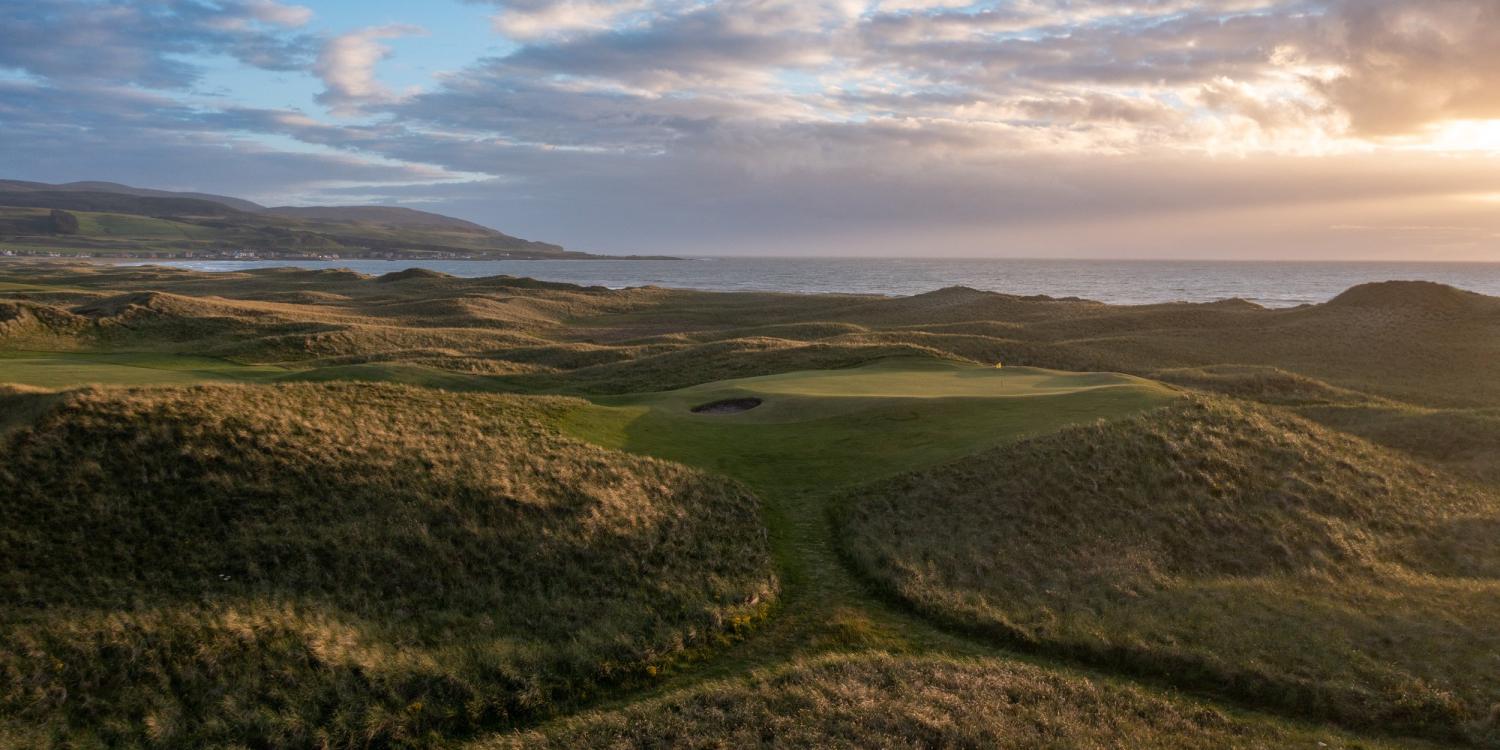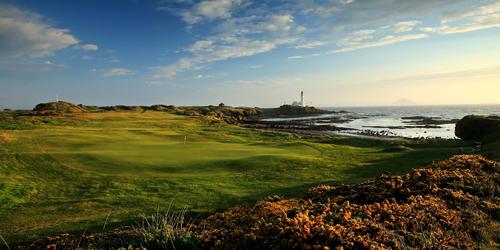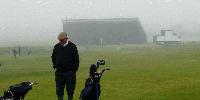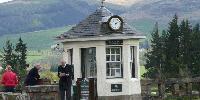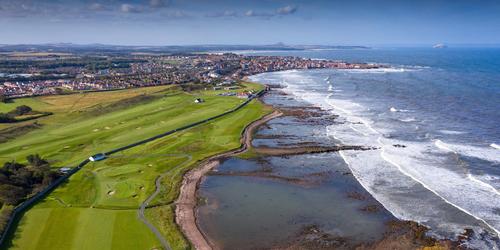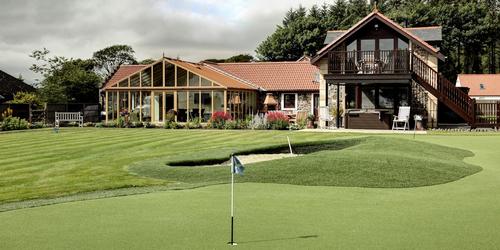Machrihanish Golf Club
A glimpse of the famous and not-so-famous golf courses of Scotland
By Blaine Newnham
If you've come all this way to Royal Troon, home of the latest British Open, why wouldn't you go a little farther - 39 miles as the crow flies - to Machrihanish, perhaps the real spiritual home of golf?
Could it be that to get there by car you need to drive 160 miles, an albeit beautiful trip north past Loch Lomond and down Paul McCartney's Long and Winding Road to the Mull of Kintyre. Beautiful but still 160 miles and three hours.
So many of us who love golf know of the Machrihanish Golf Club, but will never get there, left to wonder about the words of golf novelist Michael Bamberger who wrote, "if I were allowed to play only one course the rest of my life, Machrihanish would be the place.'"
Or Old Tom Morris's assessment of the landscape as ``specifically designed by the Almighty for playing golf.'
How special is it as a golf destination? Certainly more than ever with the addition of a second course, Machrihanish Dunes.
But one at a time.
So magical and mystical is the old course that I spent the first day passing through the dunes looking for Michael Murphy's Shivas Irons. Not that you expected to see Old Tom Morris in the local pub, but I did see someone who looked like him. Could it be?
Machrihanish remains in the hearts of some as Old Tom's best preserved work, dating to 1879 when it took the course from 10 to 18 holes.
The dunes are magnificent, the stretch of holes from No. 4 to No. 8 an entirely exciting trip over hill and dale, every hole offering heaving fairways, a few blind shots, and playing surfaces both smooth and quick.
I loved it. In so many ways, Machrihanish will bring out the best of you, the punch bowl greens cuddling, not rejecting, incoming shots, the course not too long, not too demanding, just about right.
Even though it measures only 6473 yards from the tips and has a par of 70, it has remained in most ``Top 100 in the world' rankings. Only the final two holes with interior O.B. stakes are a disappointment. Certainly, the round is not.
The opening tee shot - at one point voted the best opening hole in golf - is across as much Atlantic Ocean as you want to take on. I took a conservative route and twice found the fairway. I liked the fact you have to wait for beach walkers to clear the way and hope they shared in your accomplishment.
To get to sacred land of Machrihanish, we flew from Seattle to Dallas, from Dallas to London's Heathrow, and then to Edinburgh. Then the four-hour drive.
We returned after three wonderful rounds and days via a large car ferry from Campbeltown to Ardrosian near Prestwick that took a couple of hours.
In terms of getting there, there is also small plane service from Prestwick to an airfield once important as an outpost in World War II and right adjacent to the course.
The courses website suggests that for 119 pounds one could fly to Machrihanish from Glasgow, play a round of golf, have lunch and fly home. At the rate when we were there 119 British Pounds equalled $154 U.S. dollars. If the deal is there and you're near Prestwick, then take it.
While Machrihanish is all about the past, there is suddenly, after 100 years, another reason to make the trip.
Adjacent to Old Tom's course is David Kidd's
new course, Machrihanish Dunes, a brilliant piece of work by Kidd because of the restrictions he faced and his own earlier penchant to make courses too difficult, like Tetherow in Oregon and the Castle Course at St. Andrews.
While it is wild and wooly, the Dunes is more like what he did at Bandon Dunes and more recently at Gamble Sands in Central Washington.
What an opportunity for Kidd, a native Scot who spent summers playing on the beaches of Machirhanish. The land had been labeled environmentally sensitive and to gain permission to build in the dunes Kidd initially had only seven acres in which to shape of the 270 available to him.
Kidd bought into the idea of this being Scotland's most natural course even to the point that the famous Hebridian black sheep would mow the rough in the winter.
But the retro course - retro to the 1890s - was too natural.
In seven years the course has matured and restrictions lessened. In the beginning, the only land that could be moved involved tees and greens and the fairways could be mowed but not leveled and the rough left unmowed.
The course received many ``never agains' because the rough was unchecked, the fairways a work in progress, the blind holes confusing rather than enticing.
But at its core the site is sensational with occasional views of the Atlantic Ocean and the neighboring old course. While the fairways are a moonscape of bumps and pits, the design of the course is remarkable. And in my opinion very playable now seven years after it opened. Given the restrictions, the design is wonderful with the the exception in my mind of the final two holes, the 17th too difficult and the 18th too confusing.
Machrihanish Dunes has begun to do what town folks in nearby Campbeltown hoped it would, bringing people to the Mull of Kintyre for a stay rather than a drop-in.
There was a time before World War II that Campbeltown was home to more than 30 whiskey distilleries as well as a flush summertime crowd from near- but so far - Glasgow. They came by steamer in those days.
Machrihanish Dunes is the first course built on Scotland's West Coast in 100 years. It was initiated by former Apple executive Brian Keating and ultimately owned and developed by Southworth Development, a Boston-based firm.
Together they've spent $30 million to build the golf course, renovate the magnificent, on-site Ugadale Hotel as well as the Royal Hotel in Campbeltown. In addition, handsome stone cottages near the hotel and a remodeled pub were also renovated. In all, Machrihanish Dunes Village - what they call it now - is delightful and a bump-and-run from the fabled first tee of the old course.
The courses are both about $90 to play. A person could stay away from the madding crowds for five or six days with great enjoyment.
Revised: 02/16/2017 - Article Viewed 12,276 Times
- View Course Profile
About: Blaine Newnham
![]() Thirty five years as a sports columnist - last 23 in Seattle - during which he witnessed five Olympic Games as well as Tiger Woods four consecutive major championship victories. He covered Willie Mays when he played for the San Francisco Giants, Steve Prefontaine when he ran for Oregon, Ken Griffey Jr. when he debuted for the Seattle Mariners. He walked 18 holes with Ben Hogan at the 1966 U.S. Open, and saw Larry Mize chip in to beat Greg Norman at the Masters. He has written two books, including Golf Basics for Barnes and Noble and played everywhere from Ballybunion to Bandon Dunes, his most recent trip in May, a nine-rounds-in-seven-days gambol from Dublin to Northern Ireland and back. He and his wife, Joanna, live in Indianola, Wa.
Thirty five years as a sports columnist - last 23 in Seattle - during which he witnessed five Olympic Games as well as Tiger Woods four consecutive major championship victories. He covered Willie Mays when he played for the San Francisco Giants, Steve Prefontaine when he ran for Oregon, Ken Griffey Jr. when he debuted for the Seattle Mariners. He walked 18 holes with Ben Hogan at the 1966 U.S. Open, and saw Larry Mize chip in to beat Greg Norman at the Masters. He has written two books, including Golf Basics for Barnes and Noble and played everywhere from Ballybunion to Bandon Dunes, his most recent trip in May, a nine-rounds-in-seven-days gambol from Dublin to Northern Ireland and back. He and his wife, Joanna, live in Indianola, Wa.
Follow Blaine Newnham:
Contact Blaine Newnham:
GolfTrips.com - Contributor

